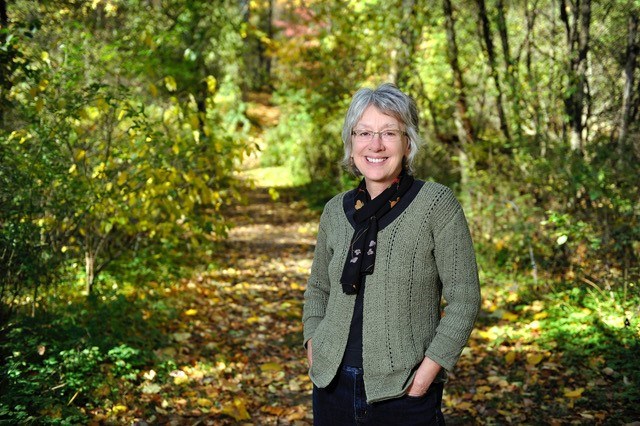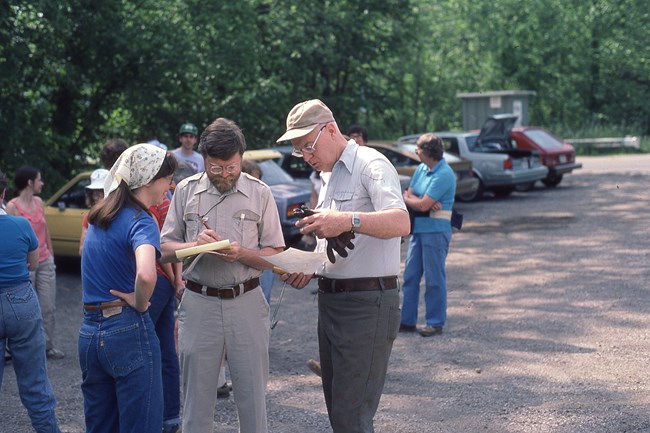Last updated: January 17, 2025
Article
Peg Bobel: Advocate, Author, and Citizen Scientist

Courtesy / Peg Bobel
“I’m most passionate about life when I go to the woods to be restored.”
Peg Bobel has been an advocate for Cuyahoga Valley National Park for half a century. She played a role in park establishment by gathering signatures of support in the early 1970s. From 1989-2001, she served as the executive director of the Cuyahoga Valley Association (CVA), the park friends' group. (This is now called the Conservancy for Cuyahoga Valley National Park.) Under her leadership, the organization saw membership growth, helped create Cuyahoga Valley Environmental Education Center, and funded many projects—from the arts to junior ranger programming. Peg Bobel has been a force of change in the Cuyahoga Valley’s history. That change all started with volunteer work and a spark of passion.
Cuyahoga Valley National Park recorded an oral history with Peg Bobel in 2022 as a part of a Women in Parks project.
Park Advocacy, Love, and the Sierra Club
Peg Bobel grew up in Cuyahoga Falls, Ohio on the edge of Cuyahoga Valley. “We went to Virginia Kendall a lot when it was a metro park—back in the 50s and 60s,” she recalled. As a young woman, Peg studied social work, first at Heidelberg College in Tiffin, Ohio and later earning her master’s degree from Case Western Reserve University in Cleveland. After graduation, she got a job as a social worker in Akron. Looking back, Peg realized that her mother had pushed her in this direction. Her mother had a difficult young life and remembered being helped by people in this profession.
While working in Akron, Peg joined the Sierra Club’s newly formed Portage Trail Group. Walter Sheppe, a biology professor at the University of Akron, launched this local chapter in 1972. Peg recalled, “My friend and I attended the first meetings that Walter had and right away the Sierra Club took on the national park advocacy as really their main mission at the time.” Back in 1970, Peg briefly worked to elect John F. Seiberling to the US House of Representatives. Once in office, “One of his first things was to propose the national recreation area.” As a Sierra Club volunteer, Peg said, “I remember being out in public places . . . We were the people out there getting folks to sign petitions supporting the park bill and writing letters.” Cuyahoga Valley National Recreation Area was created in 1974 in large part because of grassroots activism. During those early years, Peg recalled hiking what became the Old Carriage Trail. “We saw these survey stakes that the developer had put up. We got alarmed and we got in touch with John Seiberling. . . . Because what we were saying was: this area is too beautiful for it to be developed full of homes—this has to get into the park somehow.”
She traveled to Roanoke, Virginia for a large Sierra Club meeting in support of wilderness areas. There Peg met her future husband, Rob. At the time, she led the club’s Akron Area chapter and he led the Cleveland chapter. “We got interested in each other at that conference.” It was a match. From then onward, Peg and Rob have been involved with activism as life partners. (Rob Bobel spent most of his career as a civil engineer at Cuyahoga Valley National Park.)
As the park was developing, the Bobels’ volunteer work included leading the Sierra Club’s cleanup at the Beaver Marsh.

© Tom Fritsch
From Trails Council to Cuyahoga Valley Association
In the 1980s, the young Cuyahoga Valley National Recreation Area formed an ad-hoc trails committee of its Advisory Commission. This was chaired by another grassroots leader, Janet Hutchinson. The committee's goal was to explore the park and recommend the best areas for trails. This resulted in the 1985 Trails Plan. Janet encouraged volunteers from the ad-hoc committee to form the Cuyahoga Valley Trails Council. Peg was its first president. Today, Cuyahoga Valley Trails Council continues to lead trail work projects in cooperation with National Park Service staff.
Peg's Trails Council leadership led to her being hired to build the park friends’ group, initially called Cuyahoga Valley Association (CVA). “The direct connection (to the CVA) would be going from volunteering for the park to finding out I had an opportunity to work in the park in some fashion. And of course, Rob plays into this a lot . . . you talk about something being a labor of love.” Peg was the CVA's executive director from 1989 to 2001.
-
Planning Trails for the New National Park
Peg Bobel describes how she and her husband Rob helped map out a new trail system and form a volunteer organization, Cuyahoga Valley Trails Council, to support it.
- Credit / Author:
- NPS
- Date created:
- 03/08/2023
-
The Park Friends’ Group Forms
Peg Bobel explains the relationship between the Cuyahoga Valley Association and the Cuyahoga Valley Park Federation.
- Credit / Author:
- NPS
- Date created:
- 03/08/2023
-
Being Hired to Lead Cuyahoga Valley Association
Peg Bobel talks about her first involvement with the Cuyahoga Valley Association.
- Credit / Author:
- NPS
- Date created:
- 03/08/2023
Peg filled many shoes as executive director of the Cuyahoga Valley Association. She said, “CVA, when they hired me, they didn’t really have money. They had members but it was maybe in the 100s, I want to say. Because we were real proud when we built it into the thousands or the 8000s.” Peg described the early days under her leadership. “I basically just did the ‘ok let’s come up with a brochure. Let’s get a mailing list going.’ . . . I started raising money and then somewhere in there very early on we got asked to be the fiduciary for things like the Cuyahoga Valley Heritage Festival. That became a major emphasis for us to be the one to apply for grants . . . I wrote the checks. We served in that capacity.” Starting in the 1980s, CVA raised money for the early Junior Ranger program, established by Gayle Hazelwood and other park staff. Peg remembered working with Tommie Patty, who led the Phyllis Wheatley Association and served on the CVA board. The association was founded by Jane Edna Hunter to serve Cleveland’s African Americans community and operated Camp Mueller in Cuyahoga Valley.
When Ronald Reagan became president in 1981, he appointed the controversial James Watt as Secretary of Interior. Watt unsuccessfully tried to deauthorize Cuyahoga Valley National Recreation Area and other urban units of the National Park Service. Cuyahoga Valley Association and the Sierra Club were active voices throughout that fight.
-
An Attempt to Deauthorize Cuyahoga Valley
Peg Bobel describes how Secretary of the Interior James Watt attempted to deauthorize urban national recreation areas during the Reagan Administration. In 1981, a plan was proposed for the divestiture of Cuyahoga Valley and Santa Monica Mountains to state ownership. The cartoon that she mentions appears on page 173 of the park’s administrative history, A Green Shrouded Miracle.
- Credit / Author:
- NPS
- Date created:
- 03/08/2023
Another vital role for Cuyahoga Valley Association was as an incubator for other organizations. In 1988, the Cuyahoga River Remedial Action Plan (RAP) formed to serve as the local stakeholder group tasked with river clean up within the Area of Concern. Elaine Marsh remembers that people from Cuyahoga Valley participated in the first public meetings. As CVA executive director, Peg hosted the first gathering to discuss forming a separate river advocacy group. From those conversations, Friends of the Crooked River (FOCR) formed in 1990 under Jerry Welch's leadership. Elaine Marsh was the first FOCR secretary. For its first year or so, the group met at Homestead House where Peg had her office.
-
Launching Friends of the Crooked River
Peg Bobel explains how Cuyahoga Valley Association had a role in starting Friends of the Crooked River. FOTCR formed in 1990 to educate Northeast Ohio residents on the value of the Cuyahoga River and its watershed.
- Credit / Author:
- NPS
- Date created:
- 03/08/2023
Peg also recalled that, a decade later, the Countryside Initiative was initially run through the CVA. Peg worked with Darwin Kelsey to write the startup grant from the George Gund Foundation. In 1999, Countryside split off to became the national park’s non-profit partner for preserving and promoting sustainable agriculture on our historic farm properties.
Researching and Writing
Later in her career, from 2016 to 2021, Peg Bobel worked for Summit Metro Parks. She was a project-by-project contractor at first and then was hired for five years as a part-time cultural resource specialist. Peg said that she was “somewhat self-taught because my degree is in social work. . . It was more of an interest in my part.” Peg’s research shed light on the history of the former Valley View Golf Course property, now part of Cascade Valley Metro Park.
During this period, Peg also worked under contract with the University of Akron. One of her projects was to write an Akron sewage treatment history for the Water Reclamation Facility’s centennial in 2016. The current plant is along the southern border of Cuyahoga Valley National Park and includes Bath Road Heronry. It has played a critical role in the effort to restore the Cuyahoga River.
Peg has another tie to this property. She and Rob are long-time observers of Cuyahoga Valley’s wildlife. They volunteer as citizen scientists, collecting data at Bath Road Heronry and at Beaver Marsh.
Peg and Rob have shared their knowledge of nature and trails by coauthoring several books: Towpath Companion: A Traveler’s Guide to the Ohio & Erie Canal Towpath Trail, The Nature of the Towpath, and Trail Guide to Cuyahoga Valley National Park. Among her other titles, Peg Bobel collaborated with Lynn Metzger to edit Canal Fever: The Ohio & Erie Canal, from Waterway to Canalway. Peg is currently completing a book project she started with Lynn, a history of Native Americans in the Cuyahoga Valley.
Peg described herself as an avid reader with lots of role models. When asked about her inspirations, Peg named Rachel Carson and “certainly the early advocates, naturalists of the 1900s and later. Thoreau sits on my bookshelf.” But the community of Cuyahoga Valley supporters also came to her mind. “Well, it’s a mixture of the people I’ve known through the years. And the projects and the fun we’ve had together. So many of my friends still are friends I know through the park. It’s the people. It’s the experiences.”
Learn More
Look for a photo of Peg and Rob Bobel at the Ira Trailhead exhibits on your way to Beaver Marsh. Explore additional stories on our Women of Cuyahoga Valley page.
